If you’re like most women, you want a very specific type of body.
You want to be lean but not too skinny (and most definitely not “skinny fat“).
You want a toned upper body but don’t want to look like a “bulky” weightlifter.
You want a flat, defined stomach.
You want tight, shapely legs, and last but most definitely not least . . .
You want that perfect, gravity-defying butt.
Well, you—yes, lil’ ol’ you—can have all these things. You don’t need top-shelf genetics or a lifetime of training to look like a million bucks.
You have to know what you’re doing, though.
Forget what the fitness magazines have told you—you don’t become a “goddess” through starving yourself and doing a masochistic amount of cardio.
Instead, you need to take a completely different approach. And believe it or not, a much healthier, more enjoyable, and sustainable one.
In this article, you’re going to learn the best workout routine for women, as well as a 3-month female body transformation plan that will get you on your way to building the body of your dreams in no time.
- The Ultimate Workout Plan for Women
- Strength Workouts
- Cardio Workouts
- Strength Workout #1: Lower Body (Legs and Glutes)
- 1. Barbell Back Squat
- 2. Bulgarian Split Squat
- 3. Romanian Deadlift
- 4. Hip Thrust
- Strength Workout #2: Upper Body and Core
- 1. Incline Dumbbell Press
- 2. Standing Dumbbell Press
- 3. Dumbbell Side Lateral Raise
- 4. Dumbbell Overhead Triceps Extension
- Strength Workout #3: Lower Body and Pull (Legs and Back)
- 1. Barbell Deadlift
- 2. Walking Lunge
- 3. One-arm Dumbbell Row
- 4. Lat Pulldown
- HIIT Cardio Workout #1: 6 x 30
- HIIT Cardio Workout #2: 10 x 1
- Steady-State Cardio Workout
- Diet and Nutrition
- 1. Eat the right number of calories.
- 2. Eat enough protein.
- 3. Take the right supplements.
Table of Contents
Would you rather listen to this article? Click the play button below!
Want to listen to more stuff like this? Check out my podcast!
The Ultimate Workout Plan for Women
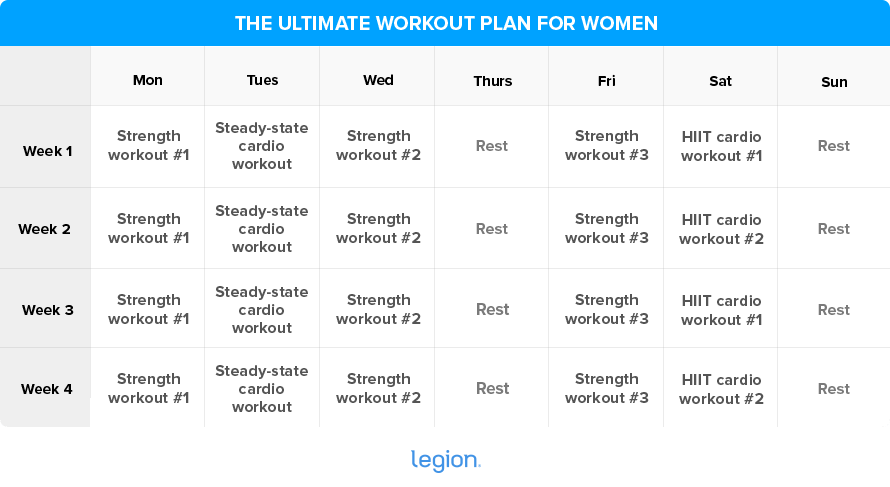
The Best 3-Month Body Transformation Plan for Females
This female body transformation plan includes the perfect mix of strength training and cardio to transform your body fast. An entire month of workouts are planned out for you—all you have to do is follow it exactly as it’s laid out, and repeat it three times back-to-back.
Make sure you take rest days as per the calendar, too. This plan is short and intense, which means you need to give your body time to recover if you want to get the best results possible.
Strength Workouts
Most workout plans for women recommend spending too much time on isolation exercises and machines, and far too little time on compound free-weight exercises.
This is wrongheaded.
The “secret” to transforming your body quickly is to get as strong as possible on compound exercises (ones that train multiple different muscle groups) like the squat, deadlift, and bench and overhead press, not futzing around with machines.
What’s more, you need to focus on getting stronger over time.
If you stop getting stronger, your muscles will eventually stop getting bigger (which means your physique will stop changing for the better).
That’s why you should also strive to add weight or reps to every exercise in every workout. This is known as progressive overload, and it’s one of the best ways to maximize the transformative effects of weightlifting.
The strength training workouts included in this gym workout routine for women are based on a standard “push pull legs” routine, but they’re modified to include a little extra work for your legs and butt since that’s what most gals want to focus on.
Each workout includes five exercises that should be done in the order they’re written, using the rep ranges and rest times provided.
Cardio Workouts
This weekly workout routine for women has you doing two cardio workouts per week: one HIIT session and one steady-state cardio session.
You can do HIIT-style training on any type of cardio equipment, but if your goal is to preserve muscle and strength (and it should be), your best choices are cycling and rowing.
Research shows that these forms of cardio can enhance weightlifting performance and don’t stress your body as much as other forms of cardio like running, which means they’re less likely to interfere with your recovery.
For your steady-state cardio sessions you can choose any form of low-impact exercise that you enjoy, such as walking, swimming, cycling, or rucking.
Want a free custom meal planning tool?
Quickly calculate your calories, macros, and even micros for losing fat and building muscle.

Strength Workout #1: Lower Body (Legs and Glutes)
1. Barbell Back Squat

3 sets | 6-to-8 reps | Rest: 2-to-3 min
The barbell back squat is hands down the most effective leg exercise you can do for transforming your lower-body. It also allows you to use heavy weights, which is best for producing high levels of tension in your muscle fibers (which is ideal for growth).
How to:
- Position a barbell in a squat rack at about the height of the top of your breast bone.
- Step under the bar, pinch your shoulder blades together, and rest the bar directly above the bony ridges on the bottom of your shoulder blades.
- Lift the bar out of the rack, take one or two steps backward, and place your feet a little wider than shoulder-width apart with your toes pointing slightly outward.
- Sit down and remember to keep your back straight and push your knees out in the same direction as your toes throughout each rep.
- Stand up and return to the starting position.
Tip: Research shows that the squat is one of the best exercises you can do to train your glutes, but if you want to get the most out of it, you have to squat to parallel or deeper.
2. Bulgarian Split Squat

3 sets | 8-to-10 reps | Rest: 2-to-3 min
Research shows that the dumbbell Bulgarian split squat is a great exercise for training the legs and glutes. Because the Bulgarian split squat trains just one leg at a time, it’s particularly useful for identifying and evening out any strength or muscle imbalances you might have, too.
How to:
- While holding a dumbbell in each hand, stand about two-to-three feet in front of a bench.
- With your right foot (and heel in particular) firmly planted, place the top of your left foot on the bench behind you.
- Look at a spot on the floor six-to-ten feet in front of you and lower your butt toward the floor by bending at your right knee.
- Keep lowering yourself until your right thigh is roughly parallel with the floor.
- Stand up and return to the starting position.
3. Romanian Deadlift
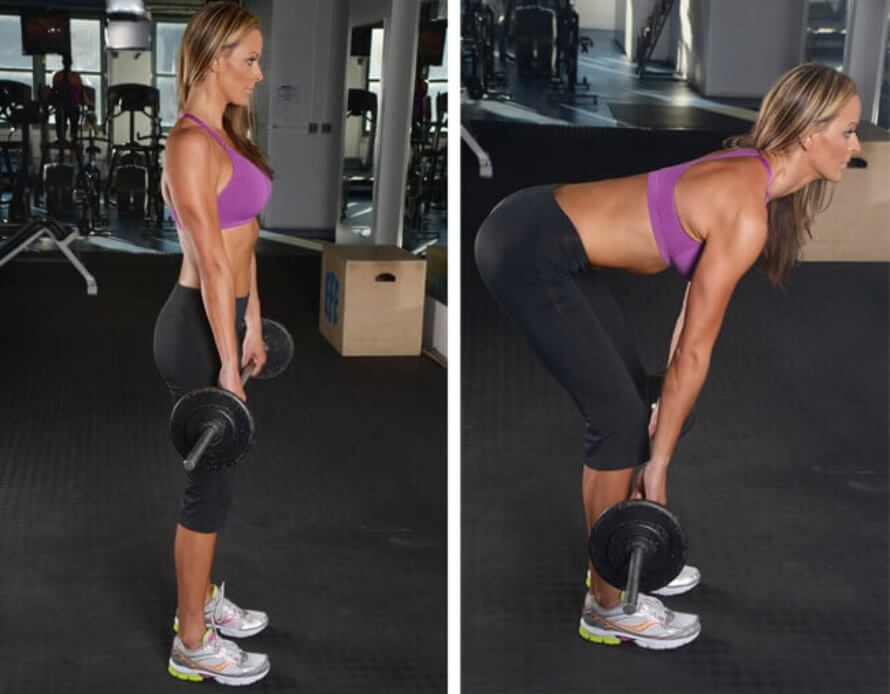
3 sets | 8-to-10 reps | Rest: 2-to-3 min
The Romanian deadlift (RDL) trains your entire posterior chain (the muscles on the back side of your body) with a large emphasis on your hamstrings and glutes.
How to:
- Stand up straight holding a loaded barbell with a shoulder-width, overhand grip (palms facing toward your body).
- Flatten your back and lower the weights toward the floor in a straight line while keeping your legs mostly straight, allowing your butt to move backward as you descend.
- Once you feel a stretch in your hamstrings, bend your knees slightly more, and continue lowering the weights until your lower back begins to round—just below the knees for most people, and about mid-shin for those who are particularly flexible.
- Reverse the movement and return to the starting position.
4. Hip Thrust
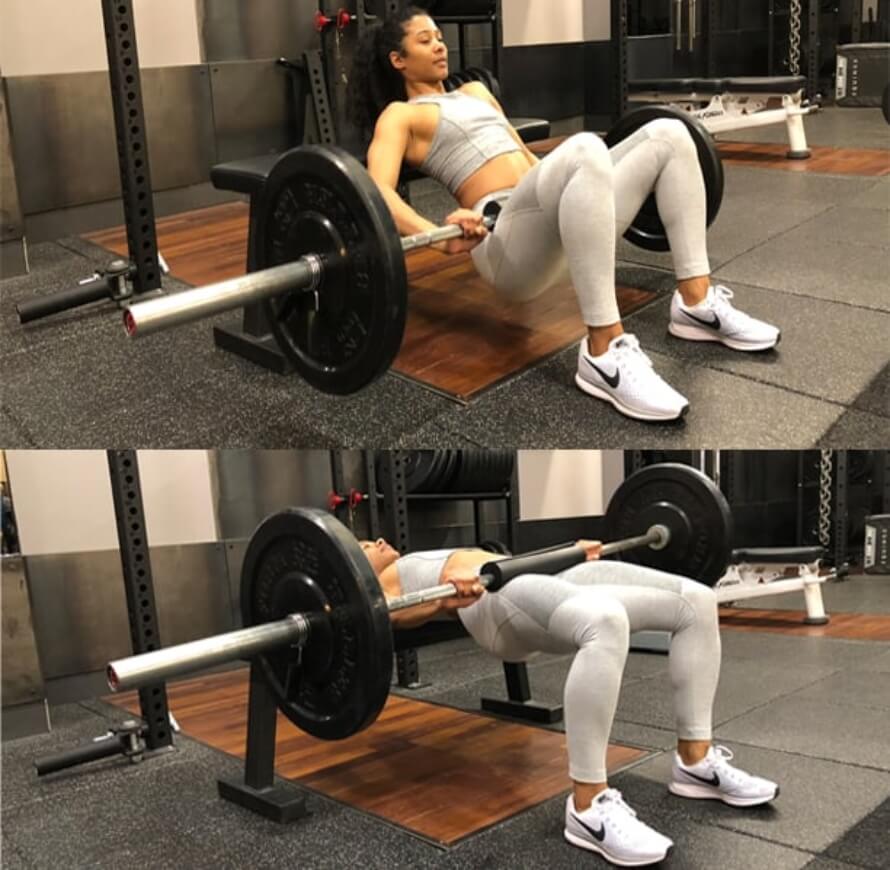
3 sets | 8-to-10 reps | Rest: 3-to-5 min
Because of the way the barbell is positioned during hip thrusts, your glutes are forced to work hard throughout the entire range of motion, which is a benefit that’s unique to this exercise.
How to:
- Sit on the ground with your back resting against a bench. The bench should be perpendicular to your body and your shoulders should be resting on the middle of the bench.
- Roll a barbell over your thighs so that it sits in your hip crease (use a bar pad to protect your hip bones from bruising and make the exercise more comfortable).
- Plant your feet on the ground about shoulder-width apart with your toes pointing slightly outward and bend your knees to 90 degrees.
- Push the bar upward with your hips by pressing through your heels until your upper body and thighs are parallel to the ground and your shins are vertical.
- Reverse the movement and return to the starting position.
Strength Workout #2: Upper Body and Core
1. Incline Dumbbell Press
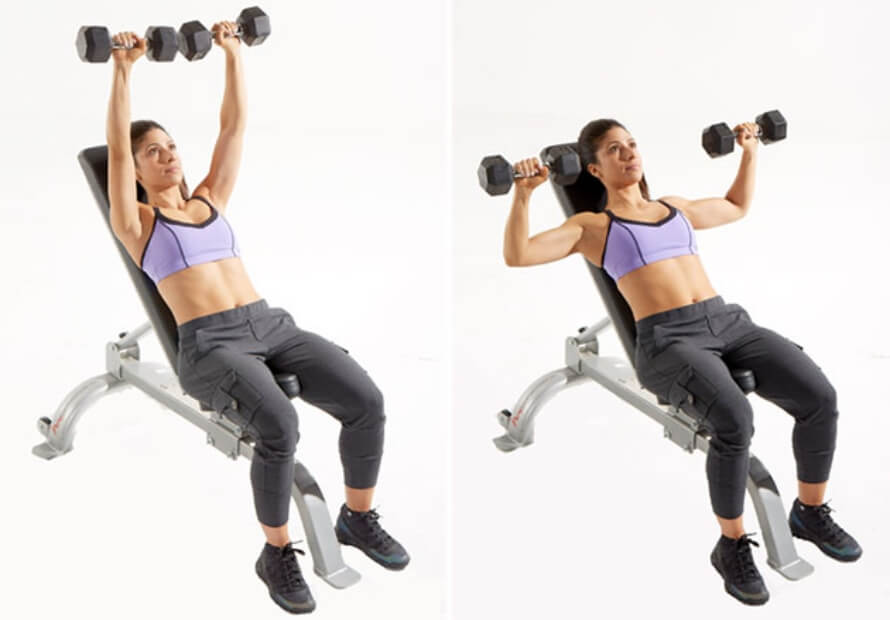
3 sets | 6-to-8 reps | Rest: 2-to-3 min
The incline dumbbell press is one of the single best exercises for building almost every major muscle in your upper body, including your pecs, triceps, and deltoids.
How to:
- While lying on a bench that’s angled at 30-to-45 degrees, hold a dumbbell in each hand and rest them on your thighs.
- Lie back, hoisting the dumbbells up so you’re holding them on either side of your chest by giving them a nudge with your thighs.
- Press the dumbbells straight up over your upper chest until your arms are straight and your elbows are locked.
- Lower the dumbbells to the starting position.
2. Standing Dumbbell Press
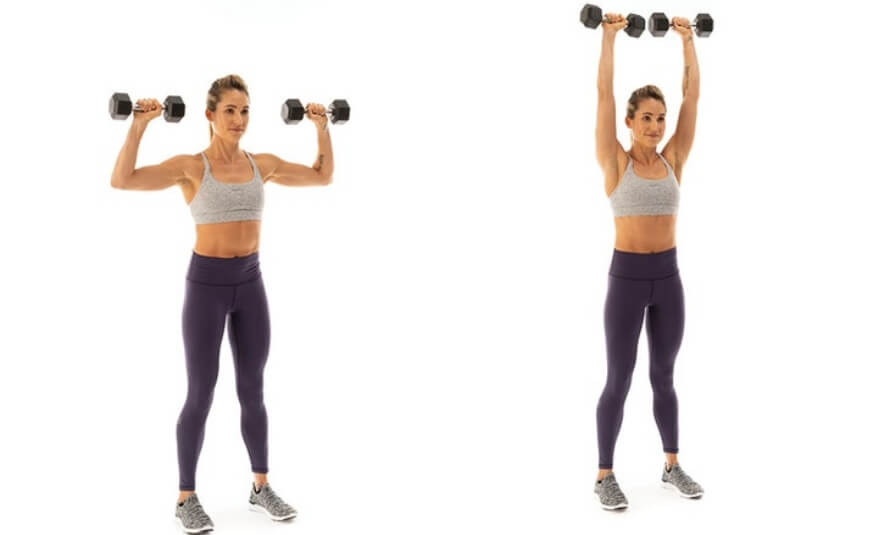
3 sets | 8-to-10 reps | Rest: 2-to-3 min
As well as improving upper body strength, chest, shoulder, and tricep size, the dumbbell overhead press develops your whole-body balance and coordination.
How to:
- Stand up straight with a dumbbell in each hand.
- Hoist the dumbbells up so you’re holding them just above your shoulders with your palms facing away from you.
- Press the dumbbells straight up over your head until your arms are straight and your elbows are locked.
- Lower the dumbbells to the starting position.
3. Dumbbell Side Lateral Raise
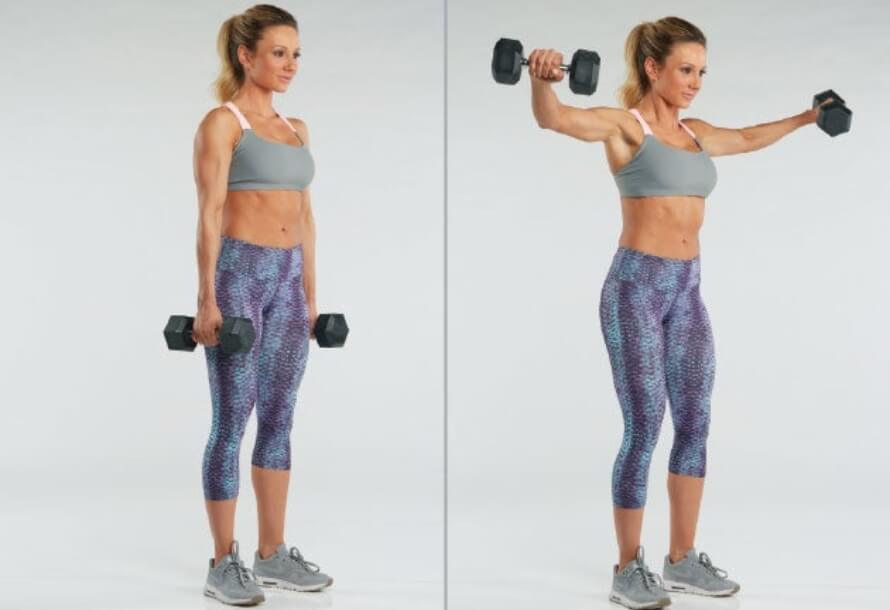
3 sets | 10-to-12 reps | Rest: 1-to-2 min
The dumbbell side lateral raise is one of the best ways to isolate the lateral (side) head of the deltoids, which is important if you want your shoulders to have full, proportionate development.
How to:
- Stand up straight with a dumbbell in each hand.
- Keeping your back straight and your core tight, raise the dumbbells out to the side until your upper arm is parallel to the floor. You don’t have to keep your arms perfectly straight—having a small bend in your elbows is normally more comfortable.
- Reverse the movement and return to the starting position.
4. Dumbbell Overhead Triceps Extension
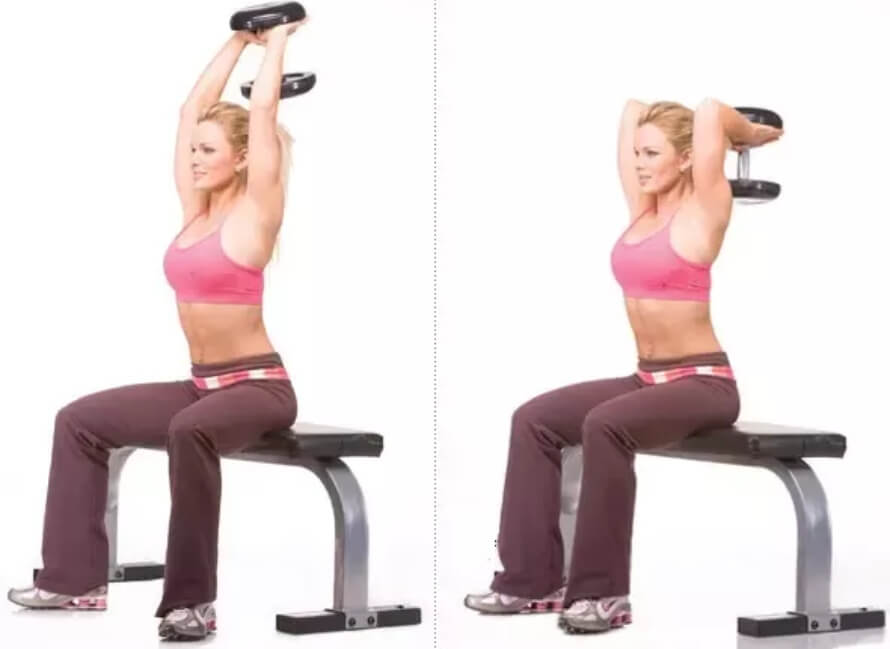
3 sets | 10-to-12 reps | Rest: 1-to-2 min
The dumbbell overhead triceps extension is one of the best triceps exercises you can do because it places the arms overhead which fully stretches the triceps. This is important because research shows that training a muscle in a stretched position may lead to more muscle growth.
How to:
- Grab a dumbbell and sit on a bench with the backrest adjusted so it’s nearly vertical.
- Extend your arms to push the dumbbell over your head, giving it a little nudge with a thigh if needed.
- Adjust your grip so your palms are supporting the weight of the dumbbell and are pointing toward the ceiling.
- Lower the dumbbell behind your head until your elbows are at a 90-degree angle, then extend your arms to return to the starting position.
Strength Workout #3: Lower Body and Pull (Legs and Back)
1. Barbell Deadlift
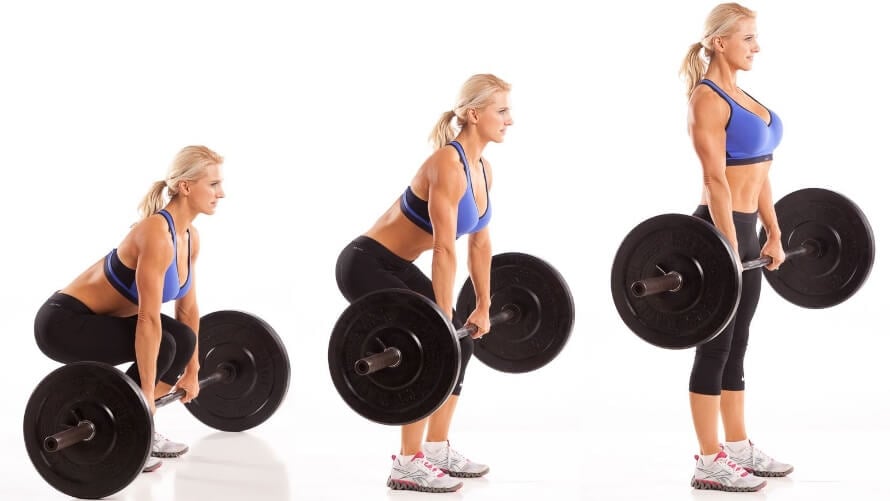
3 sets | 6-to-8 reps | Rest: 2-to-3 min
The deadlift is hands down the best exercise for training your entire posterior chain (the muscles on the back side of your body). It also allows you to use some of the heaviest weights in any of your workouts, which means it’s ideal for gaining strength and muscle.
How to:
- Position your feet so they’re slightly narrower than shoulder-width apart with your toes pointed slightly out. Move a loaded barbell over your midfoot so it’s about an inch from your shins.
- Take a deep breath into your belly, then place your hands on the bar just outside your shins with your palms facing you.
- Flatten your back and drive your body upward and slightly back by pushing through your heels until you’re standing up straight.
- Reverse the movement and return to the starting position.
Tip: If you can’t do conventional deadlifts for any reason, try sumo deadlifts or trap-bar deadlifts instead. They’re both as effective as the conventional deadlift, but some people find them more comfortable.
2. Walking Lunge
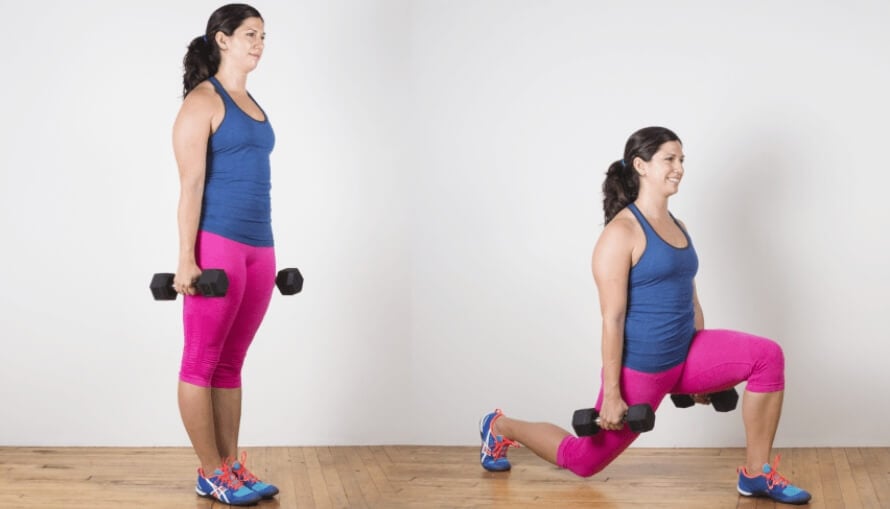
3 sets | 8-to-10 reps | Rest: 2-to-3 min
Research shows that lunges are one of the best exercises you can do to train all the muscles of your lower body, including your glutes. What’s more, stabilizer muscles across your entire body are trained because your balance and coordination is challenged as you walk.
How to:
- Holding a dumbbell in each hand, stand up straight with both feet about shoulder-width apart.
- Take a long step forward with your right foot—about two to three feet. With most of your weight on your right foot, kneel down until your left knee touches the floor.
- Push off the floor with your right foot and lean slightly backward, allowing your legs to straighten.
- Once you’re standing, bring your left foot forward so that it’s next to your right foot, then repeat on your left side.
3. One-arm Dumbbell Row
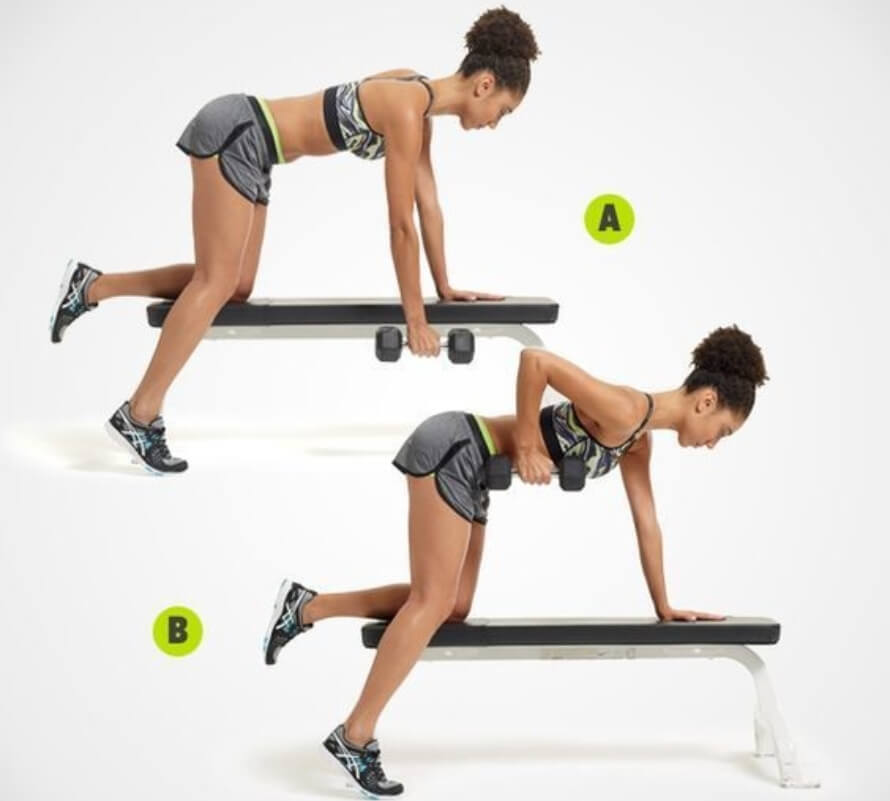
3 sets | 8-to-10 reps | Rest: 2-to-3 min
The main benefits of the one-arm dumbbell row are that it trains each side of your body independently and that you use a bench for support. This means you can lift more weight per side than you can when you do barbell rows, which is generally better for muscle growth.
How to:
- Hold a dumbbell in your right hand.
- Plant your left knee and arm firmly on a bench, your right foot on the floor a foot or two from the bench, and let your right arm (the one holding the dumbbell) hang straight down toward the floor).
- Keeping your back straight, pull the dumbbell upward until it touches your torso, and then return the dumbbell to the starting position.
- Once you’ve completed the desired number of reps, repeat the process with your left arm.
4. Lat Pulldown
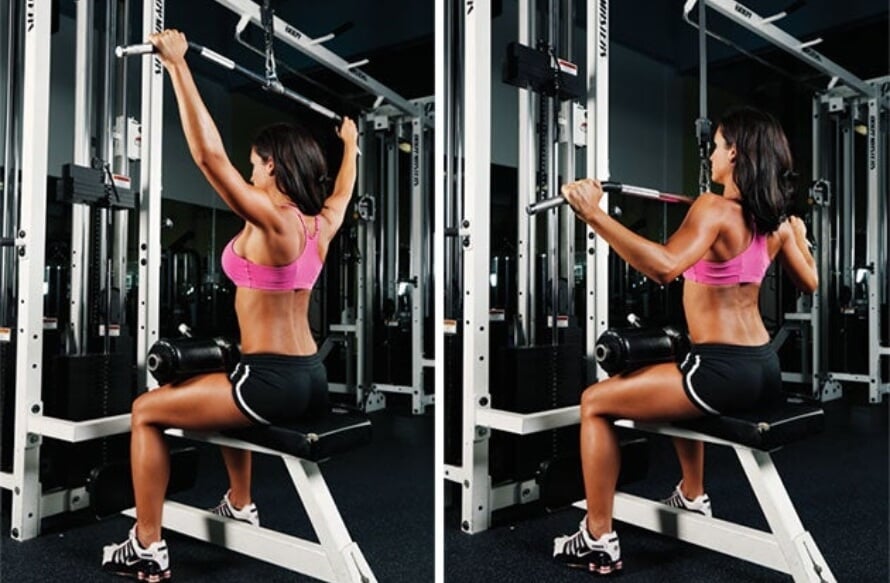
3 sets | 8-to-10 reps | Rest: 2-to-3 min
The lat pulldown is an excellent exercise for training your lats, biceps, and traps, especially for beginners who struggle to do chin-ups and pull-ups.
How to:
- Adjust the thigh pad of a lat pulldown machine so that it locks your lower body in place.
- Stand up and grab the bar. While keeping your grip on the bar and your arms straight, sit down, allowing your body weight to pull the bar down with you.
- Nudge your thighs under the thigh pads and plant your feet flat on the floor.
- Pull the bar toward your chest.
- Once the bar is underneath your chin (or touches your chest, if you want to make the exercise harder), reverse the movement and return to the starting position.
HIIT Cardio Workout #1: 6 x 30
This HIIT workout is good for beginners because the intervals are relatively short and it allows for plenty of recovery between sprints. This means it doesn’t feel as taxing as many other HIIT workout variations, but it still significantly boosts calorie burning and fitness.
How to:
- On an exercise bike or rowing machine, do a 30-second sprint at about 90% of your max effort followed by 2 minutes of active recovery.
- Repeat 6 times for a total of 15 minutes of exercise.
HIIT Cardio Workout #2: 10 x 1
In this HIIT workout the sprints are longer and the rests are shorter, which means you burn a ton of calories in a short period of time.
How to:
- On an exercise bike or rowing machine, do a 1-minute sprint at about 90% of your max effort followed by 1 minute of active recovery.
- Repeat 10 times for a total of 20 minutes of exercise.
Steady-State Cardio Workout
For your steady-state cardio workout, spend 30-to-60 minutes doing a low impact form of exercise that you enjoy, like walking, swimming, cycling, or rucking.
Diet and Nutrition
1. Eat the right number of calories.
For the most part, if you want to lose fat you need to consume fewer calories than you burn (also known as a calorie deficit), and if you want to build muscle you need to eat slightly more calories than you burn (also known as a calorie surplus).
However, when you have little to no weightlifting experience, your body is so responsive to the muscle-building effects of resistance training that you can “power through” a calorie deficit and build muscle anyway.
This is why people are able to transform their body rapidly when they first start training consistently.
Research shows that if you want to maximize fat loss while still gaining during this “newbie gains” phase, you need to use an aggressive (but not reckless) calorie deficit.
This is why I recommend that you set your calorie deficit at 20-to-25% (eat 20-to-25% fewer calories than you burn every day).
2. Eat enough protein.
When we’re talking body composition, protein is by far the most important macronutrient.
Studies show that eating adequate protein helps you . . .
- Recover faster from your workouts.
- Gain muscle and lose fat faster.
- Retain muscle better while restricting your calories for weight loss.
- Feel more satiated by your meals (and thus be less likely to overeat).
The bottom line is high-protein dieting beats low-protein in every way, especially when you’re trying to build muscle and lose fat.
What’s the right amount of protein?
If you’re looking to transform your body as quickly as possible, you should eat about 1-to-1.2 grams per pound of body weight per day.
And if you’re very overweight (30%+ body fat), then this can be reduced to around 40% of your total calories per day.
3. Take the right supplements.
I saved this for last because it’s the least important.
Unfortunately, no amount of weight loss pills and powders are going to automagically transform your body.
In fact, most fat loss supplements are completely worthless.
That said, if you know how to eat and train to drive fat loss—following the steps we just covered—certain supplements can speed up the process.
Here are the best supplements to help you build muscle and lose fat:
- 1-to-1.2 grams of protein per pound of body weight per day. This provides your body with the “building blocks” it needs to build and repair muscle tissue and help you recover from your workouts. If you want a clean, convenient, and delicious source of protein, try Whey+ or Casein+.
- 3-to-5 grams of creatine per day. This will boost muscle and strength gain, improve anaerobic endurance, and reduce muscle damage and soreness from your push pull workouts. If you want a 100% natural source of creatine that also includes two other ingredients that will help boost muscle growth and improve recovery, try Recharge.
- One serving of Phoenix per day. Phoenix is a 100% natural fat burner that speeds up your metabolism, enhances fat burning, and reduces hunger and cravings. You can also get Phoenix with caffeine or without.
The post The Ultimate 3 Month Female Body Transformation Workout Plan appeared first on Legion Athletics.
